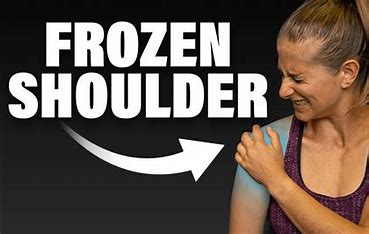If your shoulder has become stiff, painful, and harder to move over time, you could be dealing with a condition known as frozen shoulder. At You First Physio, we see this often—and the good news is that with the right treatment and support, it does get better.
👩⚕️ What is Frozen Shoulder?
Frozen shoulder, also known as adhesive capsulitis, is a condition that affects the shoulder joint, causing pain, stiffness, and a gradual loss of movement. It develops when the connective tissue surrounding the shoulder joint—called the joint capsule—becomes inflamed, thickened, and tight. This inflammation can lead to the formation of adhesions (bands of scar-like tissue) within the capsule, which significantly restricts shoulder mobility. The shoulder joint is a ball-and-socket joint that relies on a loose, flexible capsule to move freely in all directions. When this capsule tightens and loses elasticity, simple daily activities—such as reaching overhead, dressing, or sleeping—can become painful and difficult.
Frozen shoulder typically develops slowly and progresses through three stages—freezing, frozen, and thawing—over a period of several months to a few years. It is most common in people aged 40 to 60, and occurs more frequently in women. The risk is higher in individuals with diabetes, thyroid disorders, or those who have experienced shoulder injuries, surgeries, or periods of immobility. While it can affect both shoulders, it rarely occurs in both at the same time. Though the process can be frustrating, most people recover fully with the right combination of physiotherapy, self-management, and time.
🌀 The Three Stages of Frozen Shoulder
Frozen shoulder develops gradually and typically follows three distinct stages. Each phase can last several months, and symptoms evolve over time. Understanding these stages helps ensure the right treatment and exercises are done at the right time—not too much, and not too little.
1. Freezing Stage (Painful Stage)
Duration: Typically lasts 6 weeks to 9 months
🔍 What You’ll Notice:
- A slow onset of shoulder pain, often felt deep in the joint
- Pain is often worse at night, disrupting sleep
- Movement becomes increasingly limited, especially overhead or behind-the-back movements
- Even small tasks like reaching into the back seat or lifting a kettle can become painful
🎯 What We Focus On:
- Reducing pain and inflammation through gentle therapy and self-management strategies
- Maintaining as much movement as possible without aggravating symptoms
- Avoiding complete immobilisation, which can worsen stiffness
🏋️ Helpful Exercises:
- Pendulum Swings – Lean forward and let the affected arm dangle. Gently swing in circles or back and forth. This uses gravity to gently mobilise the joint with minimal strain.
- Table Slides – Sit at a table with a towel under your hand. Slide the hand forward slowly to encourage movement in a safe range.
- Isometric Shoulder Holds – Gently press your hand into a wall without moving your arm (e.g. pressing forward, sideways, or into internal rotation). These help maintain muscle engagement without joint movement.
2. Frozen Stage (Stiff Stage)
Duration: Usually lasts 4 to 12 months
🔍 What You’ll Notice:
- Pain may start to ease, especially at rest
- Stiffness becomes the primary issue—the shoulder feels locked or frozen
- Daily activities like getting dressed, washing hair, or fastening a bra become difficult or impossible
- Movement is very restricted in all directions
🎯 What We Focus On:
- Improving range of motion using targeted stretches
- Joint mobilisation techniques, often done by a physiotherapist
- Gradually introducing more active movement as tolerated
🏋️ Helpful Exercises:
- Towel Stretch Behind Back – Hold a towel behind your back with one hand up and one down. Use the good arm to gently stretch the frozen one.
- Wall Climb – Face a wall and use your fingers to “walk” your hand upward, encouraging gradual elevation of the shoulder.
- External Rotation with Stick – Hold a broomstick or dowel with both hands and use the non-affected arm to push the affected arm outward into gentle rotation.
3. Thawing Stage (Recovery Stage)
Duration: May last 6 months to 2 years
🔍 What You’ll Notice:
- Pain continues to decrease, and you may only feel discomfort at the end of your range
- Shoulder movement starts to return—often gradually and unpredictably
- You can begin to rebuild strength and function in daily tasks
🎯 What We Focus On:
- Restoring full shoulder mobility through progressive stretches and active movement
- Rebuilding strength in the rotator cuff and shoulder blade muscles
- Ensuring a safe return to daily activities, work tasks, and sport or hobbies
🏋️ Helpful Exercises:
- Resistance Band Rows – Anchor a resistance band and pull back, squeezing the shoulder blades. This strengthens the muscles that stabilise the shoulder.
- Overhead Reach with Light Weights – Lie on your back or stand and raise a small weight or object overhead to reintroduce full-range strength.
- Sleeper Stretch – Lie on your side with the affected arm under you, bent at 90 degrees. Gently push the forearm downward to stretch the back of the shoulder.
✅ Support from Your Physio Team
At You First Physio, we’re here to help you every step of the way. Depending on what stage you’re in, we may recommend:
✔️ Hands-on therapy
✔️ Personalised home exercises
✔️ Heat therapy to ease discomfort
✔️ Guidance on pacing and avoiding flare-ups
🗓️ Book an Appointment
If your shoulder pain is affecting sleep, daily tasks, or just not improving, get in touch. Our team will assess where you’re at, explain what’s happening, and work with you to get your shoulder moving again—at your pace.
📞 Call us or book online – we’re here to help.
Your shoulder, your pace, You First.


